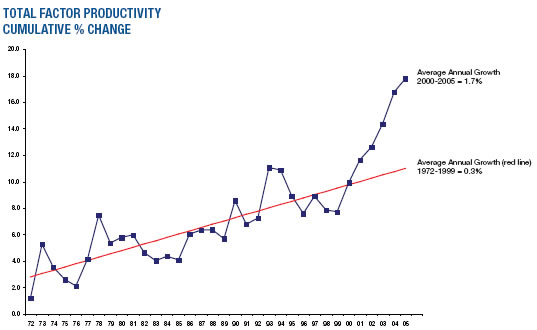 |
page 29 of 66 |  |

|
Capital Investments The Board of Governors approves the budget for investments in capital property and equipment each year. The Board also approves all major capital projects, generally defined as projects greater than $25 million. The year began with 49 Board-approved projects in progress, representing $5.0 billion in approved capital. Subsequent to the start of FY 2005, lease-only approvals not including a capital investment are no longer tracked as capital investments. As a result, one project was removed from the inventory of Board-approved capital investments during the 2005 year. During the year, the Board approved 8 new projects and modifications to 3 existing projects, totaling $1.9 billion in approved capital. 12 projects, representing $591 million in approved funding, were completed in 2005. Thus, the year ended with 44 projects amounting to $6.4 billion in approved capital. While the funding for a project is authorized in one year, the commitment, or contract to purchase or build, may occur over several years. By the close of the year, approximately $5.2 billion had been committed for these 44 projects. Similarly, actual payment for the project, or capital cash outlays, may take place over several years. By the end of 2005, approximately $2.5 billion in capital outlays had been paid against commitments made in previous years as well as commitments made in 2005 for these 44 projects. |
Of the 44 active Board-approved projects at the close of the year, 24 were for mail processing equipment, 8 for facilities, and 12 for other projects such as retail equipment and information infrastructure support. Our total capital commitment plan for 2006 is $2.9 billion, with cash outlays planned at $2.4 billion, of which approximately $1.8 billion is for commitments made in prior years and the remaining $600 million for new commitments in 2006. Our capital plan for the future calls for developing and implementing new automation equipment that will increase our operating efficiency. These programs will reduce workhours in our distribution, processing, and delivery operations. Our primary focus will be on projects that generate a high return on investment. However, we will continue to invest funds to maintain our infrastructure, including facilities, vehicles, and technology systems. Our facilities program will continue to address life, health, safety, and security issues. We will invest in facilities to support our network requirements. With projected annual average growth of approximately 2 million delivery points each year, we will maintain our infrastructure through high priority replacement projects and ongoing repair and alteration projects. |